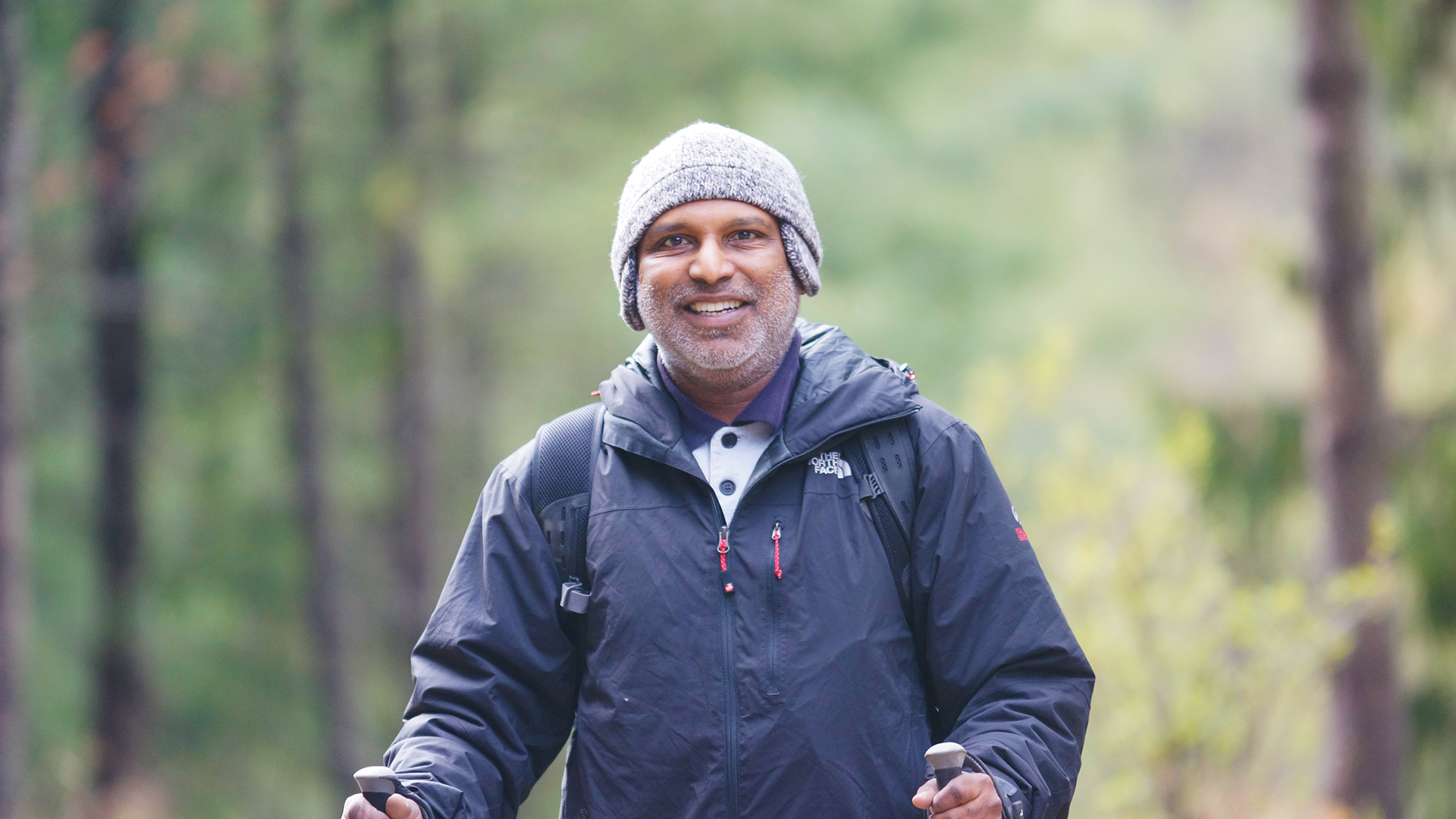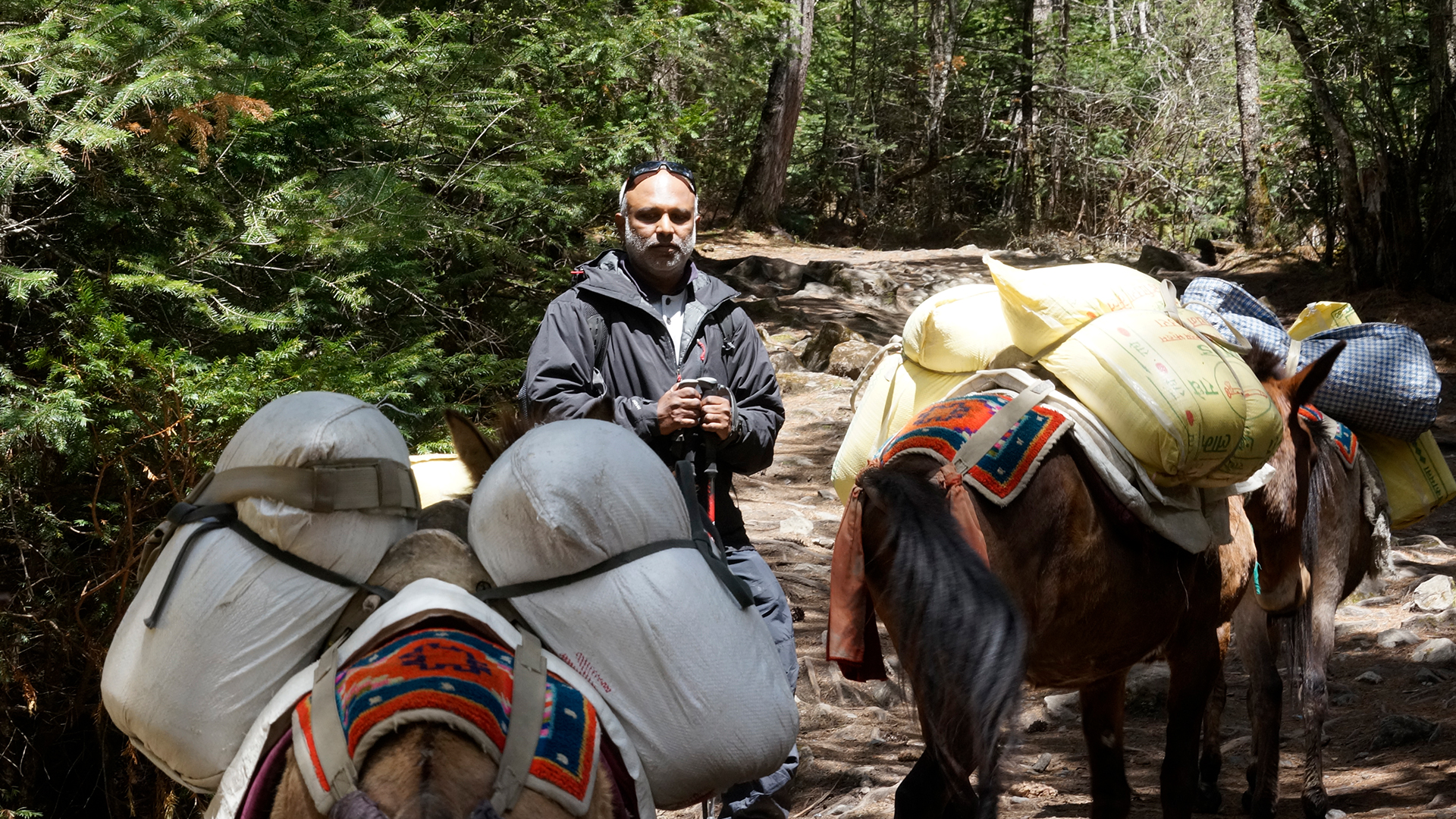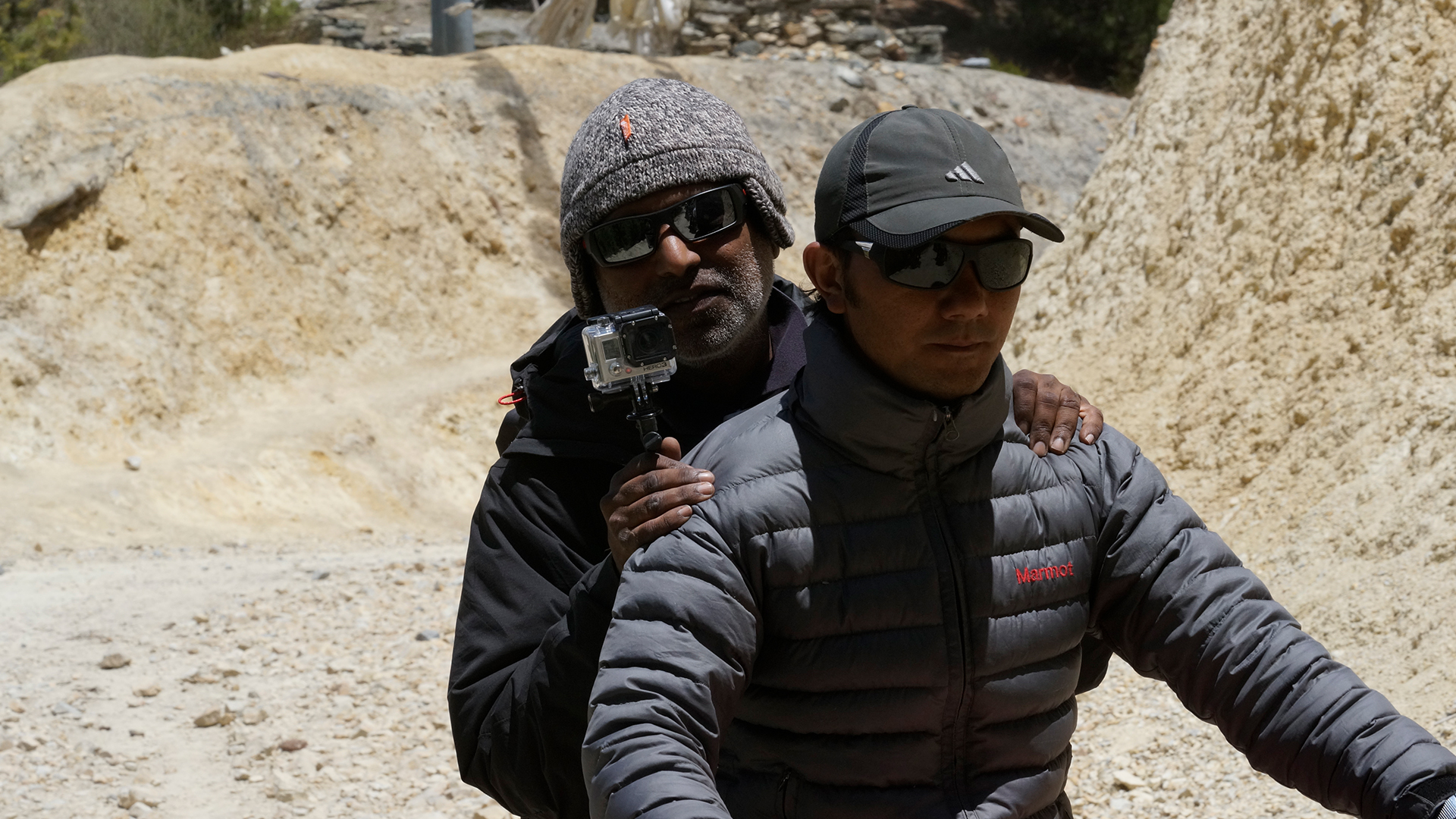
Bakkwa eating CEO who crossed Thorong-La pass at 5416 Meters in the Himalayas
How many Singaporean CEOs have you come across who have walked up to the summit of Bukit Timah Hill all of 164 meters tall? Chances are, very few. What about Mount Faber and Fort Canning Hill?
In February 2014, a Singaporean IT executive who had only been up to the height of 4095 meters at Mount Kinabalu in his younger days set his eye on reaching a staggering height of 5416 meters in the Nepalese Himalayas. Fifty-year-old Managing Director of Blue Ocean Systems, Singapore decided to join the support crew of the Yak Ru Annapurna Challenge Mountain Bike Race in May 2014. The race traverses the Annapurna Mountain Range. The inhospitable terrain makes it one of the toughest mountain bike stage races in the world.
A few quick sessions at the AthleteLab and regular brisk walks in the evening with his Husky, he was all set with two months of preparation to conquer his dream of crossing Thorong La in the Annapurna Mountain range. With some anxiety and much anticipation (well-disguised), he landed in the capital city of Kathmandu after a short 4.5 hour Silk Air direct flight from Singapore. The first two days were spent hanging around with the local race organizers and the racers. It must have been a form of acclimatization to be able to breathe in the dusty conditions of Nepal for someone coming from dust and fume free Singapore.
The Yak Ru Annapurna Challenge race start point is about an 8-hour bus drive from Kathmandu. The ride itself is very scenic if one can keep his/her eyes open during the journey and not doze off. Arun was good at keeping pace with the local crew who chowed down their food (Dal-Bhat) like Bruce Lee eating noodles. The food and nature stops along the journey are moments well spent with your fellow riders and supporters. Arun was extremely good with people, and he is quickly liked by the locals. After a back-breaking bus ride, the entourage arrived at the gateway town of Besi Sahar at an altitude of just 800 meters above sea level. This is the last chance for the race team to have a night of comfortable sleep in a decent motel with modern facilities such as electricity, room with airconditioning, hot water for shower and good food. After the race had started all race participants on the trails had to make do with more straightforward facilities and simpler but nourishing food. From this point, Arun was paired up with two race organizers.

Race Day 1
– In Nepal, the monsoon season starts around May, and this year was no exception. The break of dawn brought a torrential downpour that threatened to disrupt the race. Organizers were frantic and running about town to buy plastic sheets and raincoats to keep crew members and their belongings dry. Several hours were lost in the morning. Eventually, there was a break in the downpour. This gave the Yak Ru organizers a small window to flag off the race, and they capitalized on it. The race was now officially flagged off by a thrilled Race Director, Chhimi Gurung, with his whistle and the Yak Ru flag.
All the riders disappeared in a flash leaving the race crew to catch up with them at the finish line at Bahun Danda an 8-hour trek. The first day’s trek was not too challenging – mostly over gentle hills and village trails. Since the race was run through the villages where regular trekking groups seldom walk, we did not have access to facilities to have refreshments. Arun had to rely on his water bottles for hydration and the limited amount of high energy snacks that he had brought specially for this trip. After the first three hours, he started to experience fatigue. But he continued to sustain the pace to reach the stage finish point. What was particularly difficult for him was to keep pace with the local support crew who were used to the terrain and they walked a lot quicker than him. With many stops throughout the day, Arun finally reached the finish line at Bahun Danda. Day one was now under his belt. After a hearty Dhal Bhat meal to fill his stomach, he was instantly at ease and looked forward to a good night’ s rest.
Race Day 2
-The next morning, the sky was overcast, but fortunately for all of us, it did not start to rain. Arun decided to walk with the advance race crew who had set off early in the morning at 6am to be ahead of the mountain bike racers. The advance crew members consisted of a medical doctor who was familiar with the treatment of altitude sickness, photographers, videographers, and some support staff. The trail became more challenging as the team slowly start to gain altitude in the Annapurna Mountain range. The trail cuts through steep rock along the mighty Marshyangdi River. After about three hours or approximately 15 kilometres of trekking, the team reached Syange and crossed the Marshyangdi River to meet drivers with their robust four-wheel-drive support vehicles. The support crew then continued their journey on a jeep track which was still under construction. The road cut through some of the most dangerous mountainside roads – rocky with loose earth sections. The way appeared to be impossible to be driven on by any sane drivers. Arun gritted his teeth and hung on to his seat to survive the treacherous drive to the village of Chame situated at the height of 2800 meters above sea level. That day had a different type of challenge. It was a day to survive a hell of a ride sitting in the rear seat of the Jeep and holding on till he reached the destination. Exhausted and hungry, Arun walloped the Dal Bhat meal like a local porter. Till today he swears that the Dal Bhat that he had at Chame was the best Dal Bhat meal he ever had in his life.
Race Day 3
-The morning saw one of the riders pull out of the race citing abdominal injury from a fall sustained earlier in the day. Now all the riders and crew were ready for Day 3 of Yak Ru Annapurna Challenge. All of us knew that it would be more robust as we were then dealing with high altitude mountain conditions. It was going to get colder and steeper from there to Manang. Arun again joined the advance crew team members. The terrain got interesting as they trekked along beautiful pine tree-lined forest trails. The air got drier, but since the area was covered by the rain shadow, they were not rained on. Arun stopped every few hundred meters from catching his breath, and this was the terrain that he was not used to. Fortunately, as he reached Dhikur Pokhari, a group of motorcyclists was waiting to pick up the crew of four. The Race Director had arranged for these riders to take the team as pillions on their bikes. The mountain bike racers would have covered the distance in less than half the time of the trekkers. The racers biked through Ghyaru (walking trail). At the same time, the motorbikers rode along the Jeep track to reach Manang at 3800 meters above sea level. You may assume that it would be fun to be a pillion on a motorcycle in this terrain.
It was tough being a pillion rider on a bike ridden by someone who had consumed a significant amount of alcohol in an attempt to stay warm! The urban motorbikes made riding on slippery mountain roads a challenge. At the same time, pillions tried to stay balanced on the bikes with their heavy backpacks. Upon reaching Manang though, Arun forgot all his misery as the village offered several delights such as hot Cappuccino, fresh bakery items, and even Internet connection and oh yeah hot water for a refreshing shower. He had to use a bucket full of boiling water to feel human again. The evening felt less rushed as the next day was a rest day in Manang to acclimatize before setting off to the higher ground towards Thorong La base camp. Everyone was in a relaxed mood and swapped stories of the exciting day they had just completed.

Race Day 4
-The scheduled rest day in Manang wasn’t precisely without any action though. One of the Korean racers developed a severe strain in his leg sustained from a fall on the first day of the race. As he pushed towards the higher altitudes, his legs were, and he reached a stressful point and decided to pull out of the race. The organizers arranged for a helicopter evacuation arranged by the Nepalese Armed Forces for the rider to be airlifted to Kathmandu. The morning saw some helicopter landing and take-off excitement for everyone in the remote high mountain village, especially for the kids whose school activities were pleasantly interrupted. A walk up to the nearby glacial Lake Gangapurna and back completed the walking quota for the day. Everyone felt sufficiently acclimatized and were ready for the next day of challenges. The organizers planned to send Arun and a race official with a couple of photographers-cum-videographers to Yak Kharka on the rest day to cover some distance early so that he did not have to struggle to catch up the next day with the racers. This seemed like a good idea, and he readily agreed to walk one day ahead of the racers. So he set off with Kumar Ale (Photographer), Ajay Rana (Race Commissar) and a porter the very same afternoon.
Race Day 5
The trek for the day was from Yak Kharka to Thorong La base camp at 4800 meters, which was nothing short of demanding. After a quick breakfast, the team set off towards the higher ground. You breathe more substantial here, and the trail seemed to go up and up. The riders caught up with Arun and the skeleton crew in no time although they had started some time back from Manang. At this point, he realized what he was made of and what the racers are made of. All of a sudden, your heart is filled with a lot of respect for these great riders. You are struggling to walk, and they are riding the same trail on a mountain bike. You wonder if their lungs are built differently than yours. Among the racers, they notice a much weaker Korean rider who was struggling to stay on his bike; occasionally dismounting from his bike and trying his best to get back on it again. By the time the struggling Korean rider made it to the Thorong La base camp, his health condition had deteriorated to the point that he had become too weak to stand on his own. His oxygen saturation level fell below 30%, and he looked pale as a ghost. Doctor Abhijit from Grande Hospital immediately attended to him and administered oxygen from an oxygen canister that he had brought along. The race organizer had planned for this kind of emergencies well. A quick consultation among the organizing officials and the decision was made to airlift the sick racer back to Kathmandu. The helicopter evacuation was only possible in the morning since it was not possible for the Army helicopter to land at the base camp in the dark on short notice. The evening was tense as the race organizers attention turned towards the sick racer and his well-being. Decisions had to be made quickly and communicated back to the Army headquarters in Kathmandu to request for an early dawn helicopter rescue. Fortunately, the lodge at the base camp had a functioning high frequency based phone system which became very instrumental in the communication with the Army rescue team. The Thorong La base camp is located high in the mountain and out of the signal area of the regular GSM cell phone network. Organizers took a turn to keep a vigil over the sick racer all night long. The high altitude drama became even tenser when the sick racer adamantly repeated his wish to continue the race next morning, but the race director put his foot down and convinced the athlete that it is too risky for him to race in his condition. Eventually, he caved in, and a final decision was made to evacuate him the next morning. Everyone hit the sack early as the schedule for the following day was to get up at 3am and hit the trail by 4am to be able to cross the Pass before it became too windy from thermal currents after 10 am in the morning.
If going up Thorong La was terrible, the descent is worse! Arun’s legs were not particularly keen to hold his body weight and walk down the slope comfortably. He was literally stepping one foot in front of the other and clutching both walking poles tightly with his hands wearing those thick gloves. He walked at a snail’s pace, almost. With this speed, he was not going to make it to Kagbeni before dark. Weather changes rapidly in the mountains and especially in this part of the mountains. The descent becomes extremely painful for him and to make the matter worse, he can’t even play in his mind the option of going back. The only way to give up and go back was to walk forward and reach Kagbeni. He is left without a choice. Again, Kumar’s guidance and camaraderie kept him going. Now the day is losing sunlight rapidly, and it is getting freezing. It now starts to snow all of a sudden, as if he didn’t have enough hardship. He reached for his parka and covered himself completely to keep him dry. Now he is walking holding Kumar’s hand as he is too weak to walk alone. This continues for the next several hours until they both arrive at the base of Thorong La at the Muktinath side. A motorcycle ride is arranged for him to complete rest of the journey to reach the race finish line at Kagbeni. He was sitting almost motionless in the pillion seat of the motorcycle and clutched the rider very tightly.
Further suffering for 45 minutes of bitter cold and windy motorcycle ride down the unstable road with loose pebbles made the last part as hell as it could be. Finally, two motorcycle headlamps shine on dozens of anxious and worried race crew, and participants and the cheers and hooray that followed must have been the happiest moment of this entire journey. A happy crowd welcomed Kumar and Arun to the finish line. Perhaps the touchiest moment was when the race director Chhimi Gurung who is usually very modest, reached out and hugged Arun in elation.
Story: Sunil C. Sharma
Photos: Sunil/Kumar/Jivan
If you would like to experience the thrill of what Arun has experienced, get in touch with us to join Yak Ru 2015. Please share this post with your friends who may be interested in an adventure of this nature. Thank you!
Useful Notes:
1. Bakkwa Chinese grilled meat delicacy.
2. Thorong La Pass – a mountain pass that stays as the highest Pass in the world with an elevation of 5,416 meters (17,769 ft) above sea level in the Damodar Himal, north of the Annapurna Himal, in central Nepal.
3. Mount Kinabalu – is a prominent mountain on the island of Borneo in Southeast Asia.
4. Dhal Bhat – refers to a traditional meal which is popular in many areas of Nepal, Bangladesh, and India.
5. Rain Shadow – a dry area on the lee side of a mountainous area (away from the wind).

